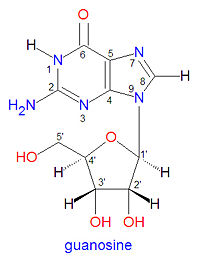Guanosine: Difference between revisions
Jump to navigation
Jump to search

imported>David E. Volk mNo edit summary |
mNo edit summary |
||
| Line 16: | Line 16: | ||
}} | }} | ||
'''Guanosine''' (GUA) is a natural biomolecule found in [[DNA]] and [[RNA]] that is formed by the combination of two ring systems, namely [[guanine]] (top) and [[ribose]] (bottom). In DNA the ribose ring is the 2'-deoxy form. It becomes incorporated into these nucleci acids via 5'-phosphorylated derivatives. In duplex DNA, guanosine is base-paired with a [[cytosine]] base (cytodine) on the opposite DNA strand. | '''Guanosine''' (GUA) is a natural biomolecule found in [[DNA]] and [[RNA]] that is formed by the combination of two ring systems, namely [[guanine]] (top) and [[ribose]] (bottom). In DNA the ribose ring is the 2'-deoxy form. It becomes incorporated into these nucleci acids via 5'-phosphorylated derivatives. In duplex DNA, guanosine is base-paired with a [[cytosine]] base (cytodine) on the opposite DNA strand.[[Category:Suggestion Bot Tag]] | ||
Latest revision as of 07:01, 24 August 2024
|
| |||||||
| guanosine | |||||||
| |||||||
| Uses: | DNA RNA biomolecules | ||||||
| Properties: | nucleotide | ||||||
| Hazards: | |||||||
| |||||||
Guanosine (GUA) is a natural biomolecule found in DNA and RNA that is formed by the combination of two ring systems, namely guanine (top) and ribose (bottom). In DNA the ribose ring is the 2'-deoxy form. It becomes incorporated into these nucleci acids via 5'-phosphorylated derivatives. In duplex DNA, guanosine is base-paired with a cytosine base (cytodine) on the opposite DNA strand.
